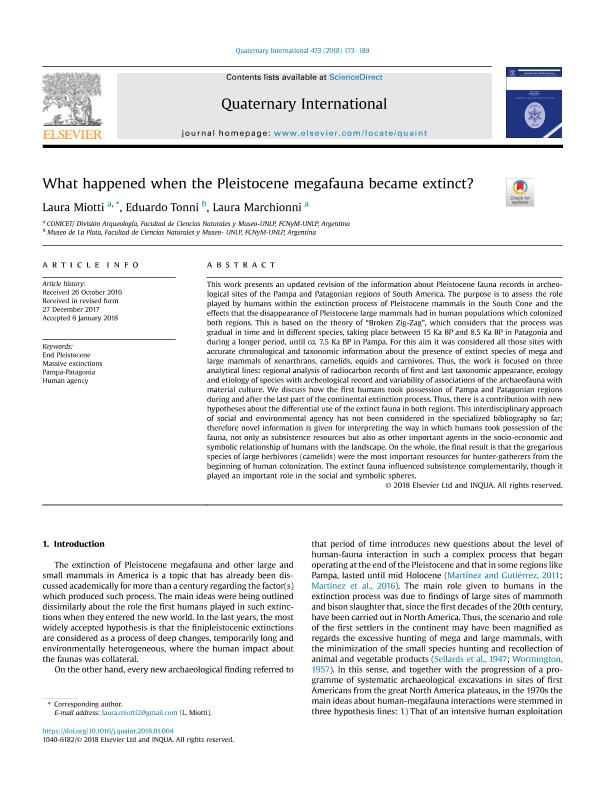Mostrar el registro sencillo del ítem
dc.contributor.author
Miotti, Laura Lucia

dc.contributor.author
Tonni, Eduardo Pedro

dc.contributor.author
Marchionni, Laura

dc.date.available
2018-08-29T17:59:12Z
dc.date.issued
2018-04
dc.identifier.citation
Miotti, Laura Lucia; Tonni, Eduardo Pedro; Marchionni, Laura; What happened when the Pleistocene megafauna became extinct?; Pergamon-Elsevier Science Ltd; Quaternary International; 473; 4-2018; 173-189
dc.identifier.issn
1040-6182
dc.identifier.uri
http://hdl.handle.net/11336/57537
dc.description.abstract
This work presents an updated revision of the information about Pleistocene fauna records in archeological sites of the Pampa and Patagonian regions of South America. The purpose is to assess the role played by humans within the extinction process of Pleistocene mammals in the South Cone and the effects that the disappearance of Pleistocene large mammals had in human populations which colonized both regions. This is based on the theory of “Broken Zig-Zag” which considers that the process was gradual in time and in different species, taking place between 15 Ka BP and 8.5 Ka BP in Patagonia and during a longer period, until ca. 7.5 Ka BP in Pampa. For this aim it was considered all those sites with accurate chronological and taxonomic information about the presence of extinct species of mega and large mammals of xenarthrans, camelids, equids and carnivores. Thus, the work is focused on three analytical lines: regional analysis of radiocarbon records of first and last taxonomic appearance, ecology and etiology of species with archeological record and variability of associations of the archaeofauna with material culture. We discuss how the first humans took possession of Pampa and Patagonian regions during and after the last part of the continental extinction process. Thus, there is a contribution with new hypotheses about the differential use of the extinct fauna in both regions. This interdisciplinary approach of social and environmental agency has not been considered in the specialized bibliography so far; therefore novel information is given for interpreting the way in which humans took possession of the fauna, not only as subsistence resources but also as other important agents in the socio-economic and symbolic relationship of humans with the landscape. On the whole, the final result is that the gregarious species of large herbivores (camelids) were the most important resources for hunter-gatherers from the beginning of human colonization. The extinct fauna influenced subsistence complementarily, though it played an important role in the social and symbolic spheres.
dc.format
application/pdf
dc.language.iso
eng
dc.publisher
Pergamon-Elsevier Science Ltd

dc.rights
info:eu-repo/semantics/openAccess
dc.rights.uri
https://creativecommons.org/licenses/by-nc-nd/2.5/ar/
dc.subject
End Pleistocene
dc.subject
Human Agency
dc.subject
Massive Extinctions
dc.subject
Pampa-Patagonia
dc.subject.classification
Arqueología

dc.subject.classification
Historia y Arqueología

dc.subject.classification
HUMANIDADES

dc.title
What happened when the Pleistocene megafauna became extinct?
dc.type
info:eu-repo/semantics/article
dc.type
info:ar-repo/semantics/artículo
dc.type
info:eu-repo/semantics/publishedVersion
dc.date.updated
2018-08-27T12:56:29Z
dc.journal.volume
473
dc.journal.pagination
173-189
dc.journal.pais
Estados Unidos

dc.description.fil
Fil: Miotti, Laura Lucia. Consejo Nacional de Investigaciones Científicas y Técnicas; Argentina. Universidad Nacional de La Plata. Facultad de Ciencias Naturales y Museo. División Arqueología; Argentina
dc.description.fil
Fil: Tonni, Eduardo Pedro. Universidad Nacional de La Plata. Facultad de Ciencias Naturales y Museo. División Arqueología; Argentina
dc.description.fil
Fil: Marchionni, Laura. Consejo Nacional de Investigaciones Científicas y Técnicas; Argentina. Universidad Nacional de La Plata. Facultad de Ciencias Naturales y Museo. División Arqueología; Argentina
dc.journal.title
Quaternary International

dc.relation.alternativeid
info:eu-repo/semantics/altIdentifier/doi/http://dx.doi.org/10.1016/j.quaint.2018.01.004
dc.relation.alternativeid
info:eu-repo/semantics/altIdentifier/url/https://www.sciencedirect.com/science/article/pii/S1040618216313064
Archivos asociados
